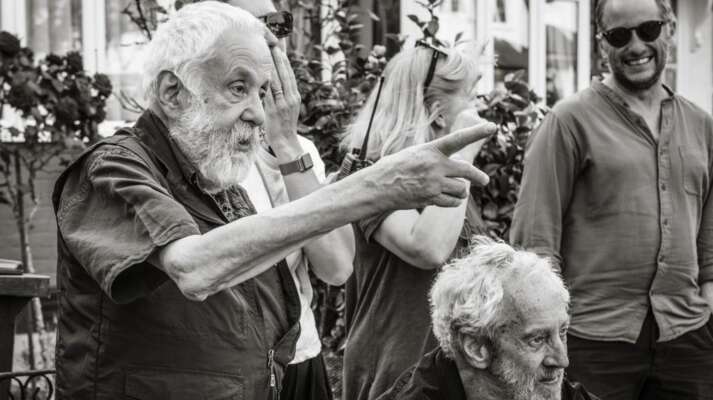Reinhard Heydrich in Film
From Hiltler's Madman to ANTHROPOID
Reinhard Heydrich in Film
Written by Peter Bowen
ANTHROPOID | Standing Up to Evil
Sean Ellis’ ANTHROPOID recounts the extraordinary true story of how two Czechoslovak patriots, Jan Kubiš (Jamie Dornan) and Jozef Gabčík (Cillian Murphy) risked everything to take out Reinhard Heydrich in 1942. Appointed Protectorate of Bohemia and Moravia, Heydrich, dubbed “The Butcher of Prague,” was one of Hitler’s most savage and influential Nazi leaders. In bringing this heroic act of resistance to the screen, Ellis shines new attention on the men and women who rose up against Nazi tyranny. While Heydrich’s bloody legacy looms large in the background, Ellis focused on the human dimension of the story. “I wanted to discover what it was like to be Jan Kubiš and Josef Gabčík, to know what it would have felt like to be confronted with the ultimate act of resistance,” Ellis explains. Since 1941, the story of Heydrich’s life and assassination has captured filmmakers’ imagination for a range of reasons. Some honored the fighters by remembering their heroism and bearing witness to the terrible reprisals enacted by the Nazis afterwards. Other filmmakers sought to uncover the depths of Heydrich’s crimes against humanity. In the following article, we survey how Heydrich’s legacy has been captured over time in film and television.
Hitler’s Madman | Heydrich as Monster

German-born director Douglas Sirk had been in Hollywood for only a year when the story of how the Nazis had completely destroyed the Czecholslovakian village of Lidice as a reprisal for the assassination of Reinhard Heydrich appeared in the news. The grim details of this episode revealed to Americans a savagery that was all too familiar to many Germans living in Hollywood. “You can’t imagine how shocked people were in this country,” Sirk told Jan-Christopher Horak. “Given that many Americans still sympathized with the Germans, Lidice made this country realize that the Nazis were animals.For the German émigrés, it meant they could never go back to Germany.” Sirk, who’d already made a name for himself in Germany under the name Detlef Sierck, jumped at the chance to tell this ripped-from-headlines tale as his first film. Rushed into production at the Poverty Row studio PRC with a miniscule budget, the film still attracted an extraordinary team of German expats. Producer Seymour Nebenzal (who included Fritz Lang’s masterpiece M among his credits) oversaw the production, which included unaccredited work from legendary German cinematographer Eugen Schüfftan, noir master Edgar G. Ulmer, writer Emil Ludwig, and Austrian composer Eric Zeisl. In casting the title Nazi, however, Sirk did not reach out to a German, but to the acclaimed American theater actor John Carradine. For Sirk, Carradine’s main draw was not his talent, but his uncanny resemblance to Heydrich. Having met Heydrich at an UFA studio party in Berlin years before, Sirk never forgot his look, or the sound of his voice. “He was in a mufti, but he had the Nazi button and he looked and behaved just like Carradine,” recalls Sirk. “He had the same edginess of speech, a certain dry theatricality.” Privately, Sirk described Carradine as “a Shakespearean actor, with a reputation of going overboard. A lot of Nazis behaved like Shakespearean actors.” To frame his film, Sirk used a voice-over narration of Edna St. Vincent Millay’s renowned poem "The Murder of Lidice." Written in 1942 in response to a Writers’ War Board’s request for all artists to keep the tragedy alive, Millay’s verse caught the public’s imagination, being broadcast on radio and reprinted in magazines. Despite its bare-bones production, Sirk’s style and the film’s timely subject matter caught the attention of studio head Louis B. Mayer, who, in an unprecedented move, acquired the B movie for a MGM release. After some reshoots and additional cameos, Hitler’s Madman hit theaters in 1943, less than a year after Heydrich’s death, as a sort of historical horror film.
Hangmen Also Die! | Heydrich as Public Enemy

Where Douglas Sirk’s Hitler’s Madman sensationalizes the events surrounding Heydrich’s assassination, Fritz Lang’s Hangmen Also Die! celebrates the unity and bravery of the Czechoslovakian people in not turning over the Nazi’s assassin. Although Heydrich appears in the film (played by the German actor Hans Heinrich von Twardowski), the film’s focus is on the fate of his killer. When it was written in 1942, the exact details of Operation Anthropoid were still confidential, and, thus, Lang and his writer Bertolt Brecht had to create a fictional drama about a patriot, Karel Vanek (Brian Donlevy), who attempts to escape under the identity of Dr. Franticek Svoboda after killing Heydrich. As the Nazis intensify their manhunt, threatening to kill hostages (and then doing so) if the killer is not handed over, the general public, including a banned professor (played by Walter Brennan), shield Vanek. While a historical fiction, the terse plot won over many critics. “As melodrama it still frequently reveals Mr. Lang as a master of concentrated suspense,” applauds The New York Times. Today the film is also remembered as acclaimed German playwright Bertolt Brecht’s sole screen credit. After arriving Hollywood in 1941, Brecht, whom Lang often referred to as “the only genius among us,” struck up a partnership with the director. In June 1942, the two registered a 32-page treatment with the Screen Writers Guild called 437!—the number denoting how many Czechoslovakians were killed to find Heydrich’s assassin. Just as soon as the two great German artists joined forces to shine a light on Nazi horrors, things fell apart. Brecht, unable to accept the profit-seeking platitudes of Hollywood, recoiled at Lang’s notes. “There is a remarkable term that always crops up whenever the logic of events or of the continuity cries out to be discussed: ‘the public will accept that’,” wrote Brecht snidely in his journal. “The public accepts the mastermind of the resistance hiding behind a curtain when the Gestapo searches a house.” To keep up with the production demands, Lang hired another writer, John Wexley, who ended up getting sole screenwriter credit. Brecht, who left the US suddenly after being called up before the House Un-American Activities Committee (HUAC) in 1947, never wrote another Hollywood film. To add insult to injury, the film’s credits shortened the German playwright’s name to the very Americanized “Bert Brecht.”
Atentát | Heydrich as National Target

In 1964, the Czech filmmaker Jiří Sequens brought to the screen the assassination of Reinhard Heydrich and its aftermath withAtentát (Assassination). Focusing primarily on the agents sent to take out Heydrich (played by German actor Siegfried Loyda) and the terrible reprisals enacted by the Nazis afterwards, Atentát spoke to its national audience, albeit with a tone that was sanctioned by the communist state. Sequens, who studied film in Moscow and Paris, was an ardent communist who attempted to infuse traditional film genres, like action movies and detective yarns, with party ideology. In Atentát he brought both these aspects to bear as he crafted a taut war thriller that rewrote history to fit government needs. After winning a Golden Prize at the Moscow Film Festival, the film went on to receive rave reviews, gaining a reputation, as Radio Praha notes, as “one of the best Czech war movies ever made.” However, many Czechs also questioned its version of events. Paul Taussig, who wrote the story for the 1996 Academy-Award winning Czech film Kolya, acknowledges the film’s excellence, but also suggests it was “heavily influenced by the communist interpretation of history.”

Conspiracy | Heydrich’s Final Solution
If early films recounted Heydrich’s assassination and its aftermath, Frank Pierson’s HBO film Conspiracy explored the dark nature of Heydrich’s legacy. On January 20, 1942, the Nazi’s top echelon convened at a lakeside estate not far from Berlin to nail down the details of the Final Solution. In less than 90 minutes, Heydrich pushed forward an agenda that sealed the fates of millions of Jews. To dramatize this historic event, Pierson gathered some of Britain and America’s finest actors. Stanley Tucci played Adolf Eichman (who engineered the Holocaust), Colin Firth was State Secretary Dr. Wilhelm Stuckart, and, most importantly, Kenneth Branagh appeared as Reinhard Heydrich. Pierson, who’d penned such classics as Cool Hand Luke and Dog Day Afternoon, conceived of dramatizing the event after seeing Heinz Schirk’s Austrian TV film Die Wannseekonferenz, which film editor Peter Zinner had given him. Returning to the actual transcripts of the conference, Pierson worked with screenwriter Loring Mandel to create a drama that felt like it was happening right before you. According to Mandel, the Wannsee Conference was for Pierson “the first Holocaust thing that he had seen that didn’t move him to tears, but moved him to anger, and that was the reason that he thought that it should be done.” Indeed Pierson designed his film to feel visceral for both the actors and audience. Shooting in long ten-minute takes, Pierson used two small 16mm cameras to gave him the flexibility to keep the action all within one room. Kenneth Branagh tells the Jewish Journal this was “the most disturbing experience of my 20-year acting career." Having only a cursory knowledge of Heydrich’s role in Nazi Germany when he began the film, Branagh remembers, “I just felt the cumulative weight of it all. At all times I was reminded that this happened: It was not a fiction. It happened in a room like this, and it took only 90 minutes, and this man, this fantastically intelligent man Heydrich, was at the heart of it.” For Branagh, Heydrich was a nearly impossible character to play. "My previous experience of playing somebody quite so dark and evil was Iago in Othello. And yet, inside that part are many motivations––sexual jealousy, thwarted ambition––that you might regard as human, however unappealing. But I didn't find that with Heydrich. It was very difficult to discover what was human inside him." The Washington Times’ Gary Arnold also noted how powerfully the film unveiled the moral emptiness of the Conference when he wrote, “They certainly got to the sickening heart of the matter with more alacrity and ironic penetration than Judgment at Nuremberg or Holocaust.”
The Man in the High Castle | Heydrich as Enduring Symbol
 While the character of Heydrich has appeared in nearly 40 films or television shows, his recent incarnation in the Amazon series The Man in The High Castle showcases how he serves as both the symbol and enigma of evil. Adapted from Philip K. Dick’s Hugo-winning sci-fi novel of the same name, the show imagines an alternate history in which the Nazis won World War II and America is now an occupied territory split between the Germans and the Japanese. While Hitler remains the ruling figurehead of the Nazi empire, Heydrich, who was never assassinated, is one of several Nazi leaders vying for control of the government. In adapting the novel, the TV series creates a spider web of interlaced storylines. In San Francisco, now located in the Japanese Pacific States, Julia Crain (Alexa Davalos) gradually joins the resistance after finding a film called The Grasshopper Lies Heavy, one of several newsreels being collected by a shadowy figure called the Man in the High Castle that shows an alternative outcome of the war, one in which the Allied Forces win. In New York City, Joe Blake (Luke Kleintank), a double agent sent to infiltrate the resistance, is sent to Canon City in the Neutral Zone, where he meets Crain. Blake’s boss in New York City is John Smith (Refus Sewell), the Greater Nazi Reich’s SS Obergruppenführer who finds himself unexpectedly enmeshed in a treasonous plot by Reinhard Heydrich (Ray Proscia) to overthrow Hitler. While set in 1962, the show’s portrayal of political savvy and genocidal practices struck many as particularly relevant. “The series is every bit as nightmarishly gripping as its literary namesake, a portrait of alt-history America so richly, intricately sketched that it almost immediately feels that most chilling of adjectives for a show of this nature: plausible,” exclaims We Got This Covered’s Isaac Feldberg. Now set for a second season, the show extends a history that Dick himself could not continue to create. When asked about a possible sequel to his novel in 1976, Dick confessed that the prospect of having to spend more time with Heydrich stopped him: “If you're going to start writing about Reinhard Heydrich, for instance, you have to get into his face. Can you imagine getting into Reinhard Heydrich's face?"
While the character of Heydrich has appeared in nearly 40 films or television shows, his recent incarnation in the Amazon series The Man in The High Castle showcases how he serves as both the symbol and enigma of evil. Adapted from Philip K. Dick’s Hugo-winning sci-fi novel of the same name, the show imagines an alternate history in which the Nazis won World War II and America is now an occupied territory split between the Germans and the Japanese. While Hitler remains the ruling figurehead of the Nazi empire, Heydrich, who was never assassinated, is one of several Nazi leaders vying for control of the government. In adapting the novel, the TV series creates a spider web of interlaced storylines. In San Francisco, now located in the Japanese Pacific States, Julia Crain (Alexa Davalos) gradually joins the resistance after finding a film called The Grasshopper Lies Heavy, one of several newsreels being collected by a shadowy figure called the Man in the High Castle that shows an alternative outcome of the war, one in which the Allied Forces win. In New York City, Joe Blake (Luke Kleintank), a double agent sent to infiltrate the resistance, is sent to Canon City in the Neutral Zone, where he meets Crain. Blake’s boss in New York City is John Smith (Refus Sewell), the Greater Nazi Reich’s SS Obergruppenführer who finds himself unexpectedly enmeshed in a treasonous plot by Reinhard Heydrich (Ray Proscia) to overthrow Hitler. While set in 1962, the show’s portrayal of political savvy and genocidal practices struck many as particularly relevant. “The series is every bit as nightmarishly gripping as its literary namesake, a portrait of alt-history America so richly, intricately sketched that it almost immediately feels that most chilling of adjectives for a show of this nature: plausible,” exclaims We Got This Covered’s Isaac Feldberg. Now set for a second season, the show extends a history that Dick himself could not continue to create. When asked about a possible sequel to his novel in 1976, Dick confessed that the prospect of having to spend more time with Heydrich stopped him: “If you're going to start writing about Reinhard Heydrich, for instance, you have to get into his face. Can you imagine getting into Reinhard Heydrich's face?"


